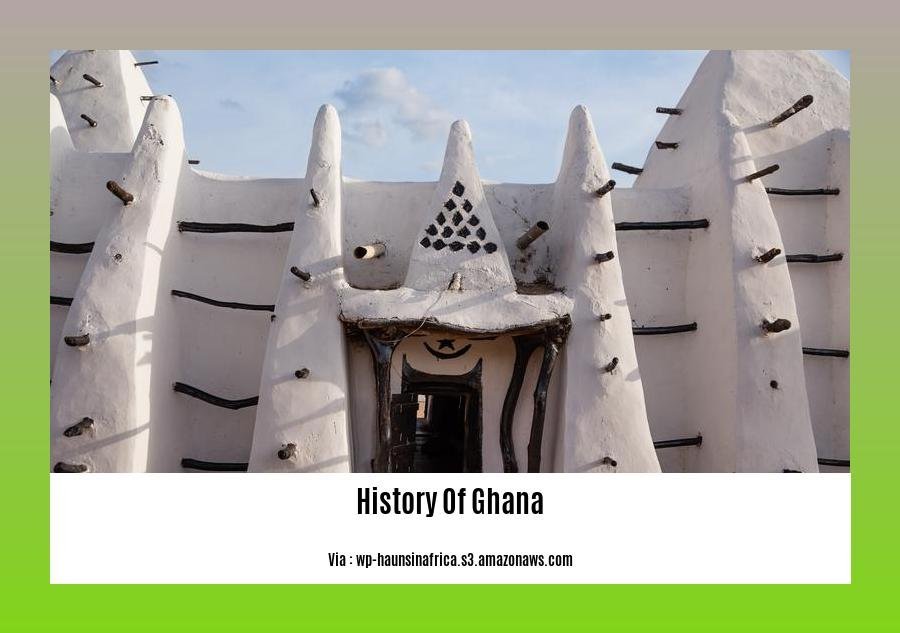Embark on a captivating historical journey through the annals of Ghana in [- A Historian’s Perspective on the History of Ghana: Unveiling the Tapestry of a Nation]. From the enigmatic origins of ancient kingdoms to the colonial era’s profound impact, the path to Ghana’s modern republic is a testament to resilience, cultural richness, and the indomitable spirit of a nation.
Key Takeaways:
- Ghana evolved from the medieval Wagadugu Empire, known for its gold and slave trade.
- The Wagadugu Empire faced decline after conflicts, drought, and invasion by the Mali Empire.
- Modern Ghana originated as the British colony, the Gold Coast, gaining independence in 1957.
- Ghana’s flag symbolizes its pan-Africanist vision inspired by Kwame Nkrumah.
- Despite challenges like coups, corruption, and poverty, Ghana has achieved progress in democracy, culture, and natural beauty.
History of Ghana

From the bustling markets of ancient Wagadugu to the vibrant streets of Accra, Ghana’s past is a captivating saga of empires, struggles, and triumphs. Its rich history has left an indelible mark on Africa and the world.
Medieval Empire:
Ghana emerged as the powerful Wagadugu Empire, controlling vast gold and slave trade routes. Its wealth and influence extended across West Africa.
Decline of Empire:
Over time, the empire faced internal conflicts, environmental challenges, and invasions, leading to its decline and fragmentation.
Modern Ghana:
In 1957, Ghana emerged as an independent nation from British colonial rule. It became a symbol of Pan-Africanism under Kwame Nkrumah’s leadership.
Challenges and Achievements:
Ghana has faced its share of challenges, including coups, corruption, and poverty. Yet, it has also made remarkable strides in democracy, culture, and education.
Flag and Pan-Africanism:
Ghana’s flag, with its vibrant red, gold, and green, represents its Pan-Africanist vision. It symbolizes the blood of independence, the wealth of its resources, and the lush greenery of its land.
A Tapestry of History:
Ghana’s history is a tapestry woven with gold, struggles, and triumphs. It is a story of resilience, determination, and a nation’s unwavering spirit. From ancient empires to modern challenges, Ghana’s past continues to inspire and shape its present and future.
Discover the fascinating history and origin of the Ancient Ghana Empire, the once-powerful West African kingdom.
Ghana’s journey toward independence from British colonial rule is an inspiring tale of resilience and determination, as chronicled in Ghana’s Independence from Britain.
Explore the transformative Kwame Nkrumah’s Leadership that shaped Ghana’s political and economic landscape during its formative years of independence.
Moving toward Independence

Ghana’s path to independence was arduous. The seeds of nationalism were sown in the late 19th century, blossoming moving toward independence under the leadership of Kwame Nkrumah.
Steps toward Self-Governance
- 1946: Constitution introduced, granting limited autonomy.
- 1951: Gold Coast (now Ghana) declared a self-governing territory.
- 1956: Gold Coast held its first general election, with Nkrumah’s Convention People’s Party securing a majority.
Key Takeaways:
- Ghana’s independence movement was fueled by nationalistic sentiment and Nkrumah’s leadership.
- Constitutional developments gradually increased autonomy.
- Ghana’s independence was a significant milestone for Africa, inspiring other nations to pursue self-governance.
Relevant URL Sources:
- The Ghana Independence (1957): A Beacon of Hope for Africa
- Ghana – Independence, Gold Coast, Kwame Nkrumah
Republic of Ghana (1957–present)
From a historian’s perspective, the Republic of Ghana, a beacon of African independence, stands as a testament to its rich heritage and enduring spirit. Its captivating history, shaped by a blend of traditional kingdoms and European influence, has laid the foundation for its vibrant present and promising future.
In 1957, the Gold Coast emerged from British colonial rule as the Republic of Ghana, marking a watershed moment in African history. The birth of an independent Ghana, spearheaded by the charismatic Kwame Nkrumah, inspired liberation movements across the continent.
Ghana’s post-independence journey has been marked by both progress and challenges. The country has navigated coups, political transitions, and economic ups and downs. Yet, its resilience shines through, reflected in its democratic institutions, thriving art scene, and natural wonders.
Key Takeaways:
- The Republic of Ghana emerged from the Gold Coast’s independence in 1957, becoming a beacon of African liberation.
- Kwame Nkrumah’s leadership and pan-Africanist vision played a pivotal role in shaping the nation’s identity.
- Despite challenges, Ghana has maintained democratic governance, fostered cultural diversity, and harnessed its natural resources for development.
- The enduring legacy of the Republic of Ghana continues to inspire generations of Africans and serve as a symbol of resilience and progress.
Sources:
– History of Ghana
– Ghana: A Historical Perspective
FAQ
Q1: When did Ghana gain independence from British rule?
A1: Ghana became the first country in Sub-Saharan Africa to gain independence on March 6, 1957.
Q2: Who was the first president of Ghana?
A2: Kwame Nkrumah became the first president of Ghana upon independence in 1957.
Q3: What was the name of the medieval empire that gave rise to the modern state of Ghana?
A3: Ghana emerged from the medieval Wagadugu Empire, which traded gold and slaves.
Q4: What are some of the challenges that Ghana has faced since independence?
A4: Ghana has faced challenges such as coups, corruption, and poverty, but has also made progress in democracy, culture, and natural beauty.
Q5: What is the significance of Ghana’s flag?
A5: Ghana’s flag reflects its pan-Africanist vision, inspired by Kwame Nkrumah, and consists of red, gold, green, and a black star.
- Crypto Quotes’ Red Flags: Avoid Costly Mistakes - June 30, 2025
- Unlock Inspirational Crypto Quotes: Future Predictions - June 30, 2025
- Famous Bitcoin Quotes: A Deep Dive into Crypto’s History - June 30, 2025
















